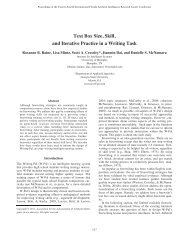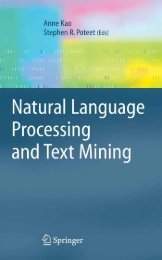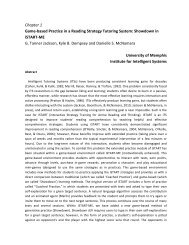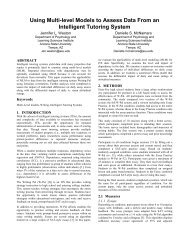Identifying Text Genres Using Phrasal Verbs
Identifying Text Genres Using Phrasal Verbs
Identifying Text Genres Using Phrasal Verbs
Create successful ePaper yourself
Turn your PDF publications into a flip-book with our unique Google optimized e-Paper software.
<strong>Using</strong> <strong>Phrasal</strong> <strong>Verbs</strong> as an Index to Distinguish <strong>Text</strong> <strong>Genres</strong><br />
Kyle B. Dempsey, Philip M. McCarthy, Danielle S. McNamara<br />
Department of Psychology<br />
Institute for Intelligent Systems<br />
University of Memphis<br />
Memphis. TN 38152<br />
{kdempsey, pmmccrth, dsmcnamr} @ memphis.edu)<br />
Abstract<br />
Previous studies have shown that text genres can be<br />
computationally distinguished by sophisticated<br />
computational and statistical methods. The current study<br />
adds to the previous body of work by incorporating phrasal<br />
verbs as a text genre identifier. Results indicate that phrasal<br />
verbs significantly distinguish between both the<br />
spoken/written and formal/informal dimensions, with<br />
considerably less computational expense than previous<br />
studies. <strong>Phrasal</strong> verbs also indicate degree of spokenness<br />
and formality that is significantly similar to previous<br />
computationally expensive studies. The study offers useful<br />
findings for text-identification research and for materials<br />
developers in the field of English as a second language.<br />
Introduction<br />
Computationally distinguishing spoken registers from<br />
written registers has been an ongoing goal of corpus<br />
linguistic research (Biber, 1988; Louwerse et al., 2004).<br />
For example, Biber (1988) used 67 shallow lexical<br />
features to study the variation in spoken versus written<br />
registers, and while he was able to report many<br />
differences within these registers, he was not able to<br />
identify an empirically defined spoken/written dimension.<br />
More recently, Louwerse et al. (2004) identified a single<br />
dimension of spoken/written registers, but only by using<br />
the significantly more sophisticated indices of cohesion<br />
and readability made available through a computer system<br />
called Coh-Metrix (Graesser et al., 2004).<br />
One linguistic characteristic that neither Biber (1988)<br />
nor Louwerse et al. (2004) considered was the incidence<br />
of phrasal verbs. <strong>Phrasal</strong> verbs are verbs plus one or more<br />
particles that behave as a syntactic and semantic, and<br />
often idiomatic, unit (Rudzka-Ostyn, 2003). <strong>Phrasal</strong> verbs<br />
have been identified as a potentially strong indicator of<br />
text genre. For example, Simpson and Mendis (2003)<br />
investigated the possibilities of variation in idiom<br />
frequency across different types of academic conversation<br />
transcriptions. Their study reported that as the particular<br />
situation changed, the type and frequency of idioms<br />
changed. As idioms are often in the form of phrasal verbs<br />
(Rudzka-Ostyn, 2003), this research leads us to<br />
hypothesize that differences in frequencies of these verbs<br />
across different types of communicative registers may<br />
facilitate making those registers more computationally<br />
identifiable. Previous research has also supported a view<br />
of phrasal verbs being a lexical marker. Biber (1987)<br />
marked phrasal verbs as a lexical phenomenon possibly<br />
occurring in varying frequency between formal and<br />
informal texts. Lastly, Darwin and Gray (1999) reported<br />
that phrasal verbs more commonly occur in freshman<br />
texts; that is, the papers of students who presumably have<br />
least experience with formal written language production.<br />
The implications for the current study are that idiomatic<br />
phrasal verbs occur in both major modes of<br />
communication to varying degrees and, therefore, that<br />
they may serve to help researchers better identify text<br />
genres.<br />
To conduct our current study, we analyzed phrasal verb<br />
occurrences across two corpora: the first being the same<br />
corpus used for the two major previous studies (i.e.,<br />
Biber, 1988; Louwerse et al., 2004), and the second being<br />
a different corpus of texts that mirrors the registers of the<br />
first corpus while more than doubling the number of texts.<br />
Purpose of the Study<br />
This study serves three major purposes. First, textbook<br />
writers for English as a Second Language (ESL) may be<br />
supplied with a better understanding of the prevalence and<br />
type of phrasal verbs and idioms. Second, researchers<br />
may be better able to identify and sort the register and<br />
quality of texts during processes such as text mining and<br />
Q&A systems (McCarthy, Briner, et al., 2006). These two<br />
fields would benefit from the current study by further<br />
narrowing the computer-driven output into more<br />
manageable samples. Finally, identifying phrasal verbs as<br />
a marker of text genre can be beneficial to current<br />
computational tools such as Coh-Metrix (Graesser et al.,<br />
2004). While this tool has already proven to be effective<br />
in a wide variety of text identification studies (e.g.,<br />
Louwerse et al., 2004; McCarthy, Briner, et al., 2006;<br />
McCarthy, Lewis, et al., 2006), the addition of phrasal<br />
verbs as a marker of text genre can increase the power of<br />
Coh-Metrix as a textual analysis tool.
Predictions<br />
Biber (1988) created an empirical separation of spoken<br />
versus written text by using a corpus of spoken text, the<br />
London-Lund corpus (LLC), and a corpus of written text,<br />
Lancaster-Oslo-Bergen (LOB). Biber’s factor analysis<br />
focuses on 67 lexical features but was unable to<br />
computationally separate the two modes. However,<br />
because phrasal verbs are believed to be more common in<br />
spoken and informal registers (CITE), we predicted that<br />
phrasal verbs frequency would be a sufficient marker to<br />
computationally discriminate between spoken and written<br />
texts. Specifically, we predicted that phrasal verbs would<br />
appear more often in spoken text than in written text.<br />
Biber (1988) identified his fifth dimension, based on<br />
degree of abstractness, as a formal/informal distinction.<br />
Biber ranked the registers within this dimension from<br />
most informal (non-abstract) to most formal (abstract).<br />
Since previous studies have suggested that phrasal verbs<br />
are more likely to be informal than formal (Biber, 1987;<br />
McWhorter, 2001), we predicted a higher frequency of<br />
phrasal verbs at the informal end of Biber’s fifth<br />
dimension.<br />
An equally interesting dichotomy reported by Louwerse<br />
et al. (2004) was their first dimension distinction between<br />
spoken and written texts. Louwerse and colleagues<br />
developed this dimension into a ranking of text registers<br />
from most spoken to most written. Since phrasal verbs are<br />
more likely contained in spoken text than in written text<br />
(Biber, 1987; McWhorter, 2001), we also predicted a<br />
higher frequency of phrasal verbs at the spoken end of the<br />
Louwerse and colleagues’ first dimension. Our<br />
predictions, therefore, were that phrasal verb frequencies<br />
would correlate significantly with Biber’s fifth dimension<br />
and Louwerse et al.’s first dimension, as these are the<br />
dimensions that most closely reflect the function of<br />
phrasal verbs. Such findings would supply evidence that<br />
phrasal verbs frequency is indicative of established text<br />
dimensions.<br />
In addition, as the Biber fifth dimension has its registers<br />
ranked in terms of degree of informality, and as the<br />
Louwerse and colleagues first dimension ranks their<br />
registers in terms of degree of spokenness, we further<br />
predicted that correlations between these individual<br />
rankings and those produced by frequencies of phrasal<br />
verbs would be significant. As such, we predicted that not<br />
only would phrasal verbs distinguish text genres along the<br />
lines of formality and spokenness, but that they would<br />
also distinguish text genres in terms of degree of<br />
formality and spokenness.<br />
Experiment 1<br />
To examine whether phrasal verbs predicted<br />
spoken/written variation and formal/informal variation,<br />
we first analyzed the same corpora as those used in the<br />
Biber (1988) and Louwerse et al. (2004) studies (see<br />
Table 1). Note, however, that as Biber’s study used an<br />
unobtainable private collection of personal and<br />
professional letters, we used the letters from the Louwerse<br />
and colleagues’ study.<br />
Table 1: Registers used in Biber (1988) and Louwerse et<br />
al. (2004).<br />
Corpus<br />
Lancaster-<br />
Olso-Bergen<br />
corpus<br />
London-<br />
Lund corpus<br />
Additional<br />
Register<br />
Press reportage, editorials, press reviews,<br />
religion, skills and hobbies, popular lore,<br />
biographies, official documents, academic<br />
prose, general fiction, mystery fiction,<br />
science fiction, adventure fiction,<br />
romantic fiction, humor<br />
Face-to-face conversation, telephone<br />
conversation, public conversations,<br />
debates, interviews, broadcast,<br />
spontaneous speeches, planned speeches<br />
Personal letters, professional letters<br />
Because the spoken corpus and written corpus differed<br />
in terms of length, only the first 1000 words from each<br />
text were considered to control for a text length confound.<br />
For a corpus of phrasal verbs, we used the 397 most<br />
commonly occurring phrasal verbs, supplied in Hart<br />
(1999). To account for grammatical variation, the phrasal<br />
verbs were transformed into five forms: base form (e.g.,<br />
go around), 3 rd person (e.g., goes around), progressive<br />
form (e.g., going around), 2 nd form (e.g., went around),<br />
and 3 rd form (e.g., gone around). Only unique<br />
transformations were considered.<br />
The frequencies of phrasal verbs were calculated using<br />
a Visual Basic program specifically written for this study.<br />
The counts were separated by verb form and text. Counts<br />
were also normalized before being output for data<br />
analysis purposes.<br />
Results<br />
An ANOVA was performed on the frequency of<br />
occurrence of phrasal verbs in the empirical separation of<br />
spoken versus written text: LOB (written)/LLC (spoken).<br />
The means are shown in Table 2. The frequencies in this<br />
analysis and in the remaining analyses tended not to be<br />
normally distributed. Therefore, we conducted the Mann-<br />
Whitney non-parametric test (i.e., U in Tables) as well as<br />
an ANOVA (F in Tables). With the exception of the<br />
frequency of 2 nd forms, all categories of phrasal forms<br />
significantly distinguished spoken from written registers.<br />
Our second question regarded the relevance of phrasal<br />
verbs to the formal versus informal distinction made by<br />
Biber (1988). Both a Mann-Whitney non-parametric test<br />
and an ANOVA were performed on the frequency of<br />
occurrence of phrasal verbs in informal versus formal
texts as separated by Biber (see Table 3). With the<br />
exception of the frequency of 3 rd persons, all categories of<br />
phrasal forms significantly distinguished formal from<br />
informal registers.<br />
Table 2: Occurrence of <strong>Phrasal</strong> <strong>Verbs</strong> in Written (W) and<br />
Spoken (S) <strong>Text</strong> (Biber, 1988).<br />
W S F U<br />
Base 2.31 4.58 76.94** 12949.5**<br />
(2.25) (3.23)<br />
0.27<br />
(0.63)<br />
0.59<br />
(0.66)<br />
2.52<br />
(2.41)<br />
0.64<br />
(0.94)<br />
Total 6.35<br />
(4.59)<br />
0.65<br />
(1.86)<br />
1.42<br />
(1.49)<br />
2.91<br />
(2.56)<br />
1.81<br />
(1.94)<br />
11.37<br />
(6.64)<br />
11.47* 21377.5*<br />
58.30** 15379.5**<br />
2.39 21531.0<br />
78.63** 144149.0**<br />
90.34** 12482.5**<br />
Notes: Standard deviations are in parenthesis; * p < .05;<br />
** p < .001<br />
Table 3: Occurrence of <strong>Phrasal</strong> <strong>Verbs</strong> in Formal (Frm)<br />
versus Informal (Inf) <strong>Text</strong> (Biber, 1988).<br />
3 rd<br />
Person<br />
Progressive<br />
2 nd<br />
form<br />
3 rd<br />
form<br />
Frm Inf F U<br />
Base 2.24 3.29 15.19** 20194.0*<br />
(1.94) (3.00)<br />
3 rd 0.39 0.38 0.01 22949.0<br />
Person (0.75) (1.27)<br />
Progressive<br />
0.60 0.94 9.12* 21445.0*<br />
(0.83) (1.25)<br />
2 nd 2.17 2.84 7.67* 21397.0*<br />
form (1.98) (2.62)<br />
3 rd 0.55 1.16 20.17** 19058.5**<br />
form (0.83) (1.56)<br />
Total 5.95 8.61 23.10** 18861.5**<br />
(3.64) (6.27)<br />
Note: Standard deviations are in parenthesis; * p < .05;<br />
** p < .001<br />
Our third question concerned the relevance of phrasal<br />
verbs to the spoken versus written distinction made by<br />
Louwerse et al. (2004). The means are shown in Table 4.<br />
An ANOVA and the Mann-Whitney non-parametric test<br />
were performed on the frequency of occurrence of phrasal<br />
verbs in spoken versus written texts as separated by<br />
Louwerse and colleagues. All categories of phrasal forms<br />
significantly distinguished Louwerse and colleagues’<br />
distinction of spoken/written registers.<br />
Our final question in Experiment 1 regarded the<br />
correlations between the frequency of phrasal verbs and<br />
the rankings reported in the Biber (1998) and the<br />
Louwerse et al. (2004) studies. The Biber study provided<br />
a ranking of the registers along an informality scale<br />
ranging from most informal (spontaneous speeches) to<br />
most formal (science texts). The Louwerse et al. (2004)<br />
study provided a ranking for the registers along a<br />
spokenness scale ranging from most spoken (interviews)<br />
to most written (professional letters). The correlations<br />
were computed between the frequency of occurrence of<br />
phrasal verbs and spokenness as postulated by Louwerse<br />
et al. (2004). As both Biber and Louwerse and colleagues’<br />
studies used factor analyses, the difference in degree<br />
between registers is difficult to assess. As such we focus<br />
on the rank positions of the registers. Such a test is nonparametric<br />
and, therefore, a Spearman correlation was<br />
conducted. The results of the correlation were significant<br />
(r = .464, p < .001), indicating a high degree of similarity<br />
between the rank order of the register findings in the<br />
Louwerse et al. study and the frequencies of phrasal<br />
verbs. The Spearman correlation between the frequency<br />
of occurrence of phrasal verbs and informality as given by<br />
Biber (1988) was also significant (r = .579, p < .001),<br />
indicating that phrasal verb frequencies are also highly<br />
indicative of formal/informal differences of register.<br />
Table 4: Occurrence of <strong>Phrasal</strong> <strong>Verbs</strong> in Written (W)<br />
versus Spoken (S) <strong>Text</strong> (Louwerse et al., 2004).<br />
W S F U<br />
Base 2.28 4.44 73.33** 13708.0**<br />
(2.28) (3.13)<br />
3 rd 0.26 0.59 7.96* 23477.5<br />
Person (0.64) (1.78)<br />
Progressive<br />
0.57 1.41 63.16** 15971.0**<br />
(0.84) (1.46)<br />
2 nd 2.43 3.07 7.18* 21393.5*<br />
form (2.35) (2.64)<br />
3 rd 0.61 1.77 83.61** 15046.5**<br />
form (0.89) (1.91)<br />
Total 6.17 11.29 100.47** 12576.5**<br />
(4.54) (6.43)<br />
Note: Standard deviations are in parenthesis; * p < .05;<br />
** p < .001<br />
Experiment 2<br />
To confirm the validity of these findings, we conducted<br />
the same experiment on a mirror corpus of that used in<br />
Experiment 1. This mirror corpus replaced the LOB texts<br />
with texts of similar length and register from the Brown<br />
corpus (Kucera & Francis, 1967) but with the main<br />
difference being number of text used. In total, 600 more<br />
texts were included in the mirror corpus. The use of the
Brown corpus to serve as a mirror was appropriate for two<br />
reasons: First, the LOB corpus was based on the Brown<br />
corpus and therefore the two corpora contain the same<br />
definition and number of registers. Second, a number of<br />
previous studies focusing on extending the findings of<br />
Biber (1987, 1988) have been conducted on the Brown<br />
corpus as opposed to the LOB corpus (e.g., Karlgren &<br />
Cutting, 1994; Kessler, Nunberg, & Schutze, 1997). The<br />
LLC texts from the original corpus were similarly<br />
replaced by spoken texts from the Wellington Corpus of<br />
Spoken English (WCS, Holmes, 1995). As the WSC<br />
corpus does not mirror the LLC corpus quite as<br />
conveniently as does Brown to LOB, we arranged the<br />
divisions of the WSC corpus into mirror registers of the<br />
LLC. Personal letters were added to the mirror corpus<br />
from a free online source (http://www.openletters.net),<br />
and the professional letter mirror corpus was compiled<br />
from business letters sent internally at the University of<br />
Memphis. As such, the complete mirror corpus matched<br />
all registers in the original corpus and more than doubled<br />
the number of texts available for analysis.<br />
Results<br />
To examine whether phrasal verbs predicted<br />
spoken/written variation in the new corpus, an ANOVA<br />
and a Mann-Whitney were performed on the frequency of<br />
occurrence of phrasal verbs in the Brown and Wellington<br />
corpora for the empirical separation of spoken versus<br />
written texts (Brown/WSC). All categories of phrasal<br />
forms significantly distinguished spoken from written<br />
registers (see Table 5). This was true even of the 2 nd<br />
person forms which were not significant in the smaller,<br />
original corpus of Experiment 1.<br />
Table 5: Occurrence of <strong>Phrasal</strong> <strong>Verbs</strong> in Written (W)<br />
versus Spoken (S) <strong>Text</strong> (Brown/WSC).<br />
Our second question regarded the relevance of phrasal<br />
verbs to the formal versus informal distinction made by<br />
Biber (1988). An ANOVA and a Mann-Whitney were<br />
performed on the frequency of occurrence of phrasal<br />
verbs in the Brown and Wellington corpora for informal<br />
versus formal texts as separated by Biber. The means are<br />
shown in Table 6. With the exception of 3 rd person forms,<br />
all categories of phrasal forms significantly distinguished<br />
formal from informal registers. These results mirror the<br />
smaller, original corpus of Experiment 1.<br />
Table 6: Occurrence of <strong>Phrasal</strong> <strong>Verbs</strong> in Formal (Frm)<br />
versus Informal (Inf) <strong>Text</strong> (Biber, 1988)<br />
Table 7: Occurrence of <strong>Phrasal</strong> <strong>Verbs</strong> in Written (W)<br />
versus Spoken (S) <strong>Text</strong> (Louwerse et al., 2004).<br />
W S F U<br />
Base 2.33 5.36 76.94** 59549.5**<br />
(2.34) (3.46)<br />
3 rd 0.30 0.57 26.45** 114531.5**<br />
Person (0.63) (0.97)<br />
Progressive<br />
0.62 1.74 150.44** 80877.5**<br />
(0.92) (1.85)<br />
2 nd 2.43 3.60 42.51** 95320.0**<br />
form (2.84) (2.88)<br />
3 rd 0.66 1.95 187.70** 72446.5**<br />
form (1.01) (1.88)<br />
Total 5.68 12.26 369.24** 49771.5**<br />
(4.85) (6.06)<br />
Note: Standard deviations are in parenthesis; * p < .05;<br />
** p < .001<br />
Frm Inf F U<br />
Base 1.93 4.49 132.30** 55374.0**<br />
(1.87) (3.45)<br />
3 rd 0.36 0.46 2.64 116085.5**<br />
Person (0.63) (0.88)<br />
Progressive<br />
0.44 1.43 84.08** 75640.0**<br />
(0.66) (1.70)<br />
2 nd 1.77 3.44 68.22** 88864.5**<br />
form (1.80) (3.10)<br />
3 rd 0.60 1.55 70.00** 69408.0**<br />
form (1.00) (1.74)<br />
Total 4.51 10.49 206.21** 44293.5**<br />
(3.08) (6.52)<br />
Note: Standard deviations are in parenthesis; * p < .05;<br />
** p < .001<br />
W S F U<br />
Base 2.18 5.36 305.46** 53697.5**<br />
(2.20) (3.44)<br />
3 rd 0.31 0.55 21.58** 98853.5<br />
Person (0.64) (0.96)<br />
Progressive<br />
0.57 1.74 166.71** 64266.5**<br />
(0.87) (1.83)<br />
2 nd 2.24 3.72 69.69** 68421.0**<br />
form (2.64) (2.99)<br />
3 rd 0.62 1.94 198.65** 65461.5**<br />
form (0.97) (1.86)<br />
Total 5.30 12.31 441.36** 44296.0**<br />
(4.48) (6.04)<br />
Note: Standard deviations are in parenthesis; * p < .05<br />
** p < .001<br />
Our third question concerned the relevance of phrasal<br />
verbs to the spoken versus written distinction made by<br />
Louwerse et al. (2004). An ANOVA and a Mann-Whitney<br />
were performed on the frequency of occurrence of phrasal<br />
verbs in the Brown and Wellington corpora for spoken<br />
versus written texts as distinguished by the Louwerse et<br />
al. (1988) 1 st dimension. The means are shown in Table 7.<br />
All categories of phrasal forms significantly distinguished
spoken from written registers. These results thus mirror<br />
the smaller, original corpus of Experiment 1.<br />
As in Experiment 1, the correlation between the<br />
frequency of occurrence of phrasal verbs and the degree<br />
of formality as given by Biber (1988) was significant (r =<br />
.656, p
Graesser, A., McNamara, D.S., Louwerse, M., & Cai, Z.<br />
(2004). Coh-Metrix: Analysis of text on cohesion and<br />
language. Behavioral Research Methods, Instruments,<br />
and Computers, 36, 193-202.<br />
Hart, C. W. (1999). The ultimate phrasal verb book.<br />
Hauppauge, NY: Barron’s.<br />
Holmes, J. (1995). The Wellington Corpus of Spoken<br />
New Zealand English: A Progress Report. New Zealand<br />
English Newsletter: 5-8.<br />
Karlgren, J. & Cutting, D. (1994). Recognizing text<br />
genres with simple metrics using discriminant analysis. In<br />
Proceedings of COLING.<br />
Kessler, B., Nunberg, G., & Schütze, H. (1997).<br />
Automatic detection of text genre. In Proceedings of the<br />
35th ACL/8th EACL, pp. 32-38.<br />
Kucera, H., & Francis, W. N. (1967). Computational<br />
analysis of present-day English. Providence, RI: Brown<br />
University Press.<br />
Louwerse, M. M., McCarthy, P. M., McNamara, D. S., &<br />
Graesser, A. C. (2004). Variation in language and<br />
cohesion across written and spoken registers. In K.<br />
Forbus, D. Gentner, T. Regier (Eds.), Proceedings of the<br />
26th Annual Meeting of the Cognitive Science Society (pp.<br />
843-848). Mahwah , NJ : Erlbaum.<br />
McCarthy, P.M., Briner, S.W., Rus, V., & McNamara,<br />
D.S. (in press). <strong>Text</strong>ual Signatures: <strong>Identifying</strong> text-types<br />
using Latent Semantic Analysis to measure the cohesion<br />
of text structures. In: A. Kao, S. Poteet (Eds.). Natural<br />
Language Processing and <strong>Text</strong> Mining. UK: Springer-<br />
Verlag.<br />
McCarthy, P.M., Lewis, G.A., Dufty, D.F., & McNamara,<br />
D. S. (in press). Analyzing writing styles with Coh-<br />
Metrix. In Proceedings of the Florida Artificial<br />
Intelligence Research Society International Conference<br />
(FLAIRS), Melbourne, Florida.<br />
McWhorter, J.H. (2001). The power of Babel: A natural<br />
history of language. Times Books: Henry Holt and<br />
Company, New York.<br />
Rudzka-Ostyn, B. (2003). Word power: <strong>Phrasal</strong> verbs and<br />
compounds: A cognitive approach. Berlin, New York.<br />
Mouton de Gruyter.<br />
Simpson, R., & Mendis, D. (2003). A corpus-based study<br />
of idioms in academic speech. TESOL Quarterly, 37<br />
(Fall) 419-441.







